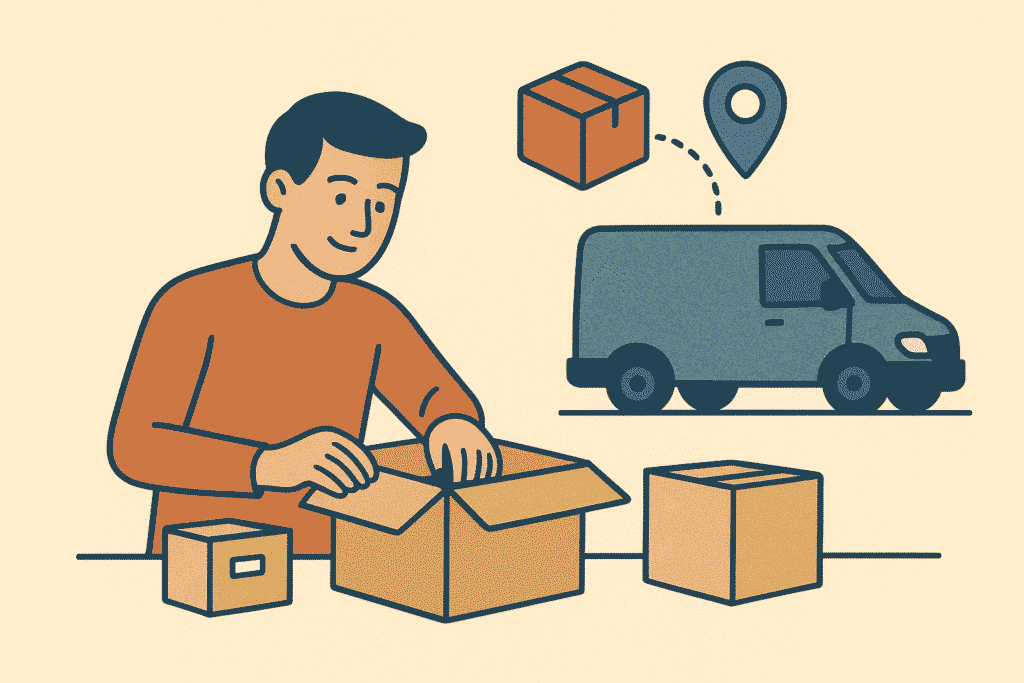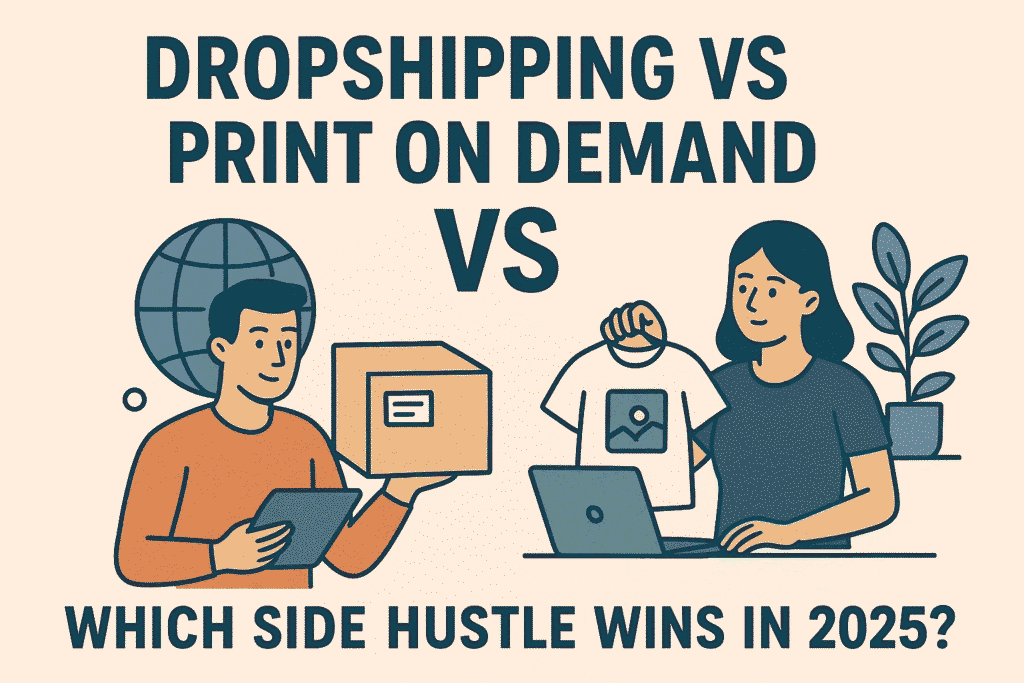Starting an online business in 2025 is easier than ever, and the debate of Dropshipping vs Print on Demand is heating up. Both models let you sell products without holding inventory, making them perfect for anyone looking to build wealth with minimal upfront costs. At HustleFinanceHub, we’re diving into Dropshipping vs Print on Demand to help you pick the right path for your financial goals. Whether you’re in Mumbai or a small town, this guide will break down costs, profits, and strategies to make your venture a success.
What Are Dropshipping and Print on Demand?
Before diving into Dropshipping vs Print on Demand, let’s clarify what each means. Both are low-risk e-commerce models that don’t require you to stock products or handle shipping. Here’s the lowdown.
Dropshipping: Sell Without Touching Products
Dropshipping lets you sell ready-made products from suppliers like AliExpress or Spocket without ever handling them. You set up an online store (e.g., on Shopify), list products, and when a customer buys, the supplier ships directly to them. In Dropshipping vs Print on Demand, dropshipping shines for its vast product range and quick setup.
Print on Demand: Create Your Own Designs
Print on Demand (POD) involves selling custom-designed products like t-shirts, mugs, or phone cases. You create or buy designs, upload them to platforms like Printify or Printful, and products are made only after a customer orders. When comparing Dropshipping vs Print on Demand, POD stands out for its creative control and branding potential.
Why Compare Dropshipping vs Print on Demand in 2025?
The Dropshipping vs Print on Demand debate matters because both can lead to financial independence with low investment. Dropshipping’s market is set to hit $2.24 trillion by 2033, while POD grows at 26.1% annually through 2030, driven by demand for custom products. Choosing the right model for your goals can turn a small investment into a steady income stream.
Pros and Cons of Dropshipping
Let’s explore the benefits and drawbacks of dropshipping to see how it stacks up in the Dropshipping vs Print on Demand comparison.
Pros of Dropshipping
- Low Startup Costs: Start with ₹5,000–₹10,000 for a Shopify store and marketing. No inventory costs make it budget-friendly.
- Wide Product Range: Sell everything from gadgets to clothes, appealing to diverse customers.
- Easy to Scale: Suppliers handle increased orders, letting you focus on marketing in Dropshipping vs Print on Demand.
- Flexibility: Pivot to trending products quickly, like smart home devices in 2025.

Cons of Dropshipping
- Lower Profit Margins: Margins of 10–20% due to supplier pricing and competition.
- Supplier Risks: Delays or poor quality can hurt your reputation.
- High Competition: Many sellers use the same suppliers, making differentiation tough in Dropshipping vs Print on Demand.
Pros and Cons of Print on Demand
Now, let’s look at POD’s strengths and weaknesses in the Dropshipping vs Print on Demand showdown.
Pros of Print on Demand
- Higher Profit Margins: Custom products fetch 20–40% margins, as you set premium prices.
- Creative Control: Design unique items to build a loyal brand.
- No Inventory Risk: Products are made on-demand, reducing waste in Dropshipping vs Print on Demand.
- Branding Potential: Add logos or custom packaging for a professional touch.
Cons of Print on Demand
- Higher Startup Costs: ₹7,000–₹15,000 for design tools (e.g., Canva Pro) and store setup.
- Slower Fulfillment: Printing takes 2–7 days, longer than dropshipping’s ready-to-ship model.
- Limited Product Range: Focus on custom items like apparel or accessories in Dropshipping vs Print on Demand.
Costs: Dropshipping vs Print on Demand
Money matters when choosing between Dropshipping vs Print on Demand. Here’s a breakdown of startup and ongoing costs for 2025.
Dropshipping Costs
- Store Setup: ₹5,000–₹10,000 (Shopify: ₹1,994/month, domain: ₹500/year).
- Marketing: ₹2,000–₹5,000/month for ads on Instagram or Google.
- Supplier Fees: Some platforms charge small fees per order.
- Total: ~₹7,000–₹15,000 to start, scalable with sales.
Print on Demand Costs
- Store Setup: ₹5,000–₹10,000 (Shopify or WooCommerce).
- Design Tools: ₹2,000–₹5,000/year (Canva Pro: ₹2,000, Photoshop: ₹20,000).
- Marketing: ₹3,000–₹7,000/month for targeted ads.
- Total: ~₹10,000–₹20,000 to start, with higher initial design costs.
In Dropshipping vs Print on Demand, dropshipping is cheaper to launch, but POD’s higher margins can offset costs over time.
Scalability: Which Grows Faster?
When evaluating Dropshipping vs Print on Demand, scalability is key for financial growth.
Dropshipping Scalability
Dropshipping scales seamlessly as suppliers handle inventory and shipping. You can add new products instantly, like trending electronics, without extra costs. However, managing multiple suppliers can get tricky in Dropshipping vs Print on Demand.
Print on Demand Scalability
POD scales well but requires ongoing design work. Platforms like Printful automate fulfillment, but growth depends on your ability to create fresh designs. In Dropshipping vs Print on Demand, POD grows slower but builds stronger brand loyalty.
Branding: Dropshipping vs Print on Demand
Branding sets your business apart, and Dropshipping vs Print on Demand differs here.
Dropshipping Branding
Dropshipping relies on generic products, making branding tough. You can use custom packaging or marketing, but competitors often sell the same items. In Dropshipping vs Print on Demand, dropshipping struggles to stand out.
Print on Demand Branding
POD lets you create unique designs, like quirky t-shirts or personalized mugs, building a distinct brand. Platforms like Printify offer custom labels for a premium feel. In Dropshipping vs Print on Demand, POD wins for brand-building.
My Experience with Dropshipping vs Print on Demand
Last year, I tested both models to boost my savings. I launched a dropshipping store selling phone accessories for ₹8,000, making ₹10,000 profit in three months but hit roadblocks with supplier delays. Then, I tried POD with custom mugs on Printful, spending ₹12,000 upfront but earning ₹25,000 profit thanks to unique designs. In my Dropshipping vs Print on Demand journey, POD felt more rewarding but took more effort. Your choice depends on your skills and time!
2025 Trends Shaping Dropshipping vs Print on Demand
The Dropshipping vs Print on Demand landscape is evolving. Here are trends to watch:
- AI Tools: Use AI (e.g., MidJourney for POD designs, ChatGPT for product descriptions) to save time in Dropshipping vs Print on Demand.
- Sustainability: POD platforms like Gelato offer eco-friendly materials, appealing to green-conscious buyers.
- Social Media: Instagram Reels and TikTok drive sales for both models in 2025.
- Fast Shipping: Dropshipping’s 10-minute delivery (e.g., via Blinkit) competes with POD’s slower fulfillment.
8 Tips to Succeed in Dropshipping vs Print on Demand
Ready to start? These tips work for both models in the Dropshipping vs Print on Demand comparison:
- Pick a Niche: Focus on specific audiences (e.g., pet lovers for POD, tech enthusiasts for dropshipping).
- Use Shopify: Its integrations with Printify and AliExpress simplify Dropshipping vs Print on Demand setup.
- Test Products: Start with 5–10 items to find winners before scaling.
- Leverage Ads: Use Instagram or Google Ads for targeted reach in Dropshipping vs Print on Demand.
- Check Supplier Quality: Order samples to ensure reliability.
- Optimize SEO: Use “Dropshipping vs Print on Demand” keywords in product titles and blogs.
- Track Data: Use Google Analytics to monitor sales and refine strategies.
- Build a Brand: Invest in logos or packaging, especially for POD.
How Dropshipping vs Print on Demand Fits Your Financial Plan
At HustleFinanceHub, we believe Dropshipping vs Print on Demand is about building wealth. Both models require low investment, letting you start with ₹10,000–₹20,000 and grow profits to fund:
- Emergency Fund: Stash earnings in a high-yield account like Kotak 811 (4–6% returns).
- Investments: Use profits to buy ETFs via Zerodha for 7–10% annual growth.
- Debt Repayment: Clear high-interest loans with business income.
For example, ₹20,000 monthly profit from Dropshipping vs Print on Demand could grow to ₹2.4 lakh yearly, a solid step toward financial freedom.
Which Should You Choose in 2025?
The Dropshipping vs Print on Demand choice depends on your goals:
- Choose Dropshipping if you want quick setup, low costs, and a wide product range. It’s great for testing markets but requires strong marketing to beat competition.
- Choose Print on Demand if you’re creative and want to build a unique brand. It takes more effort but offers higher margins and loyalty.
You can even combine both! Sell trending dropshipping products while building a POD brand for steady income. In Dropshipping vs Print on Demand, there’s no one-size-fits-all—pick what aligns with your financial vision.



Pingback: 10 AI Business Ideas You Can Start Today - hustlefinancehub.com